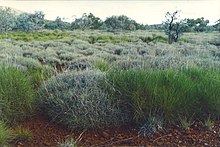Triodia (plant)
| Triodia | |
|---|---|

| |
| Triodia pungens (green) and Triodia basedowii (blue-grey) | |
| Scientific classification | |
| Kingdom: | Plantae |
| Clade: | Tracheophytes |
| Clade: | Angiosperms |
| Clade: | Monocots |
| Clade: | Commelinids |
| Order: | Poales |
| Family: | Poaceae |
| Subfamily: | Chloridoideae |
| Tribe: | Cynodonteae |
| Subtribe: | Triodiinae |
| Genus: | Triodia R.Br., 1810 |
| Synonyms[1][2] | |
| |
Triodia is a large genus of hummock-forming bunchgrass endemic to Australia. They are known by the common name spinifex, although they are not a part of the coastal genus Spinifex.[1] Many of the soft-leaved members of this species were formerly included in the genus Plectrachne.[3]
It is known as tjanpi in central Australia,[4][5] and is used for basket weaving by the women of various Aboriginal Australian peoples.[6]
A multiaccess key (SpiKey) is available as a free app for the Triodias of the Pilbara (28 species and one hybrid).[7]
Description[]
Triodia is a perennial Australian tussock grass that grows in arid regions. Its leaves (30–40 centimetres long) are subulate (awl-shaped, with a tapering point). The leaf tips, that are high in silica, can break off in the skin, leading to infections.[citation needed]
Uses[]
Spinifex has traditionally had many uses for Aboriginal Australians. The seeds were collected and ground to make seedcakes. Spinifex resin was an important adhesive used in spear-making. Smoke signals were made to communicate with families and groups a long distance away, as burning spinifex produces a strong black smoke.
The species is used for building shelters; bunched together it is used for trapping fish against creek beds. It is called baru in the languages of the Yindjibarndi and Ngarluma people, the English term is hard spinifex.[8]

Species[]
Species currently include:[9][10]
- Lazarides
- Lazarides
- (Burbidge, N.T)
- (Lazarides) Lazarides
- Lazarides
- R.L.Barrett & M.D.Barrett
- Triodia basedowii E.Pritz. – buck spinifex
- Lazarides
- Lazarides
- (Burbidge, N.T)
- (F.Muell.) Lazarides
- (S.W.L.Jacobs) Lazarides
- (S.W.L.Jacobs) Lazarides – southern porcupine grass
- S.W.L.Jacobs
- (C.E.Hubb.) Lazarides
- G.Armstr.
- Lazarides
- (Burbidge, N.T) S.W.L.Jacobs
- (Burbidge, N.T)
- (Lazarides) Lazarides
- R.L.Barrett & M.D.Barrett
- Benth.
- (F.Muell.) Lazarides
- (C.E.Hubb.) Lazarides
- (C.E.Hubb.) Lazarides
- S.W.L.Jacobs
- Barrett, Wells & Dixon
- C.A.Gardner ex N.T.Burb.
- (C.E.Hubb.) Lazarides
- (Burbidge, N.T)
- (Burbidge, N.T)
- Lazarides
- Cheel – winged spinifex
- (Burbidge, N.T)
- Triodia irritans (Brown, R) – porcupine grass
- J.M.Black
- Domin
- Lazarides
- J.M.Black
- Lazarides
- Lazarides
- (Burbidge, N.T)
- (C.E.Hubb.) Lazarides
- (Brown, R)
- Benth. – buck spinifex
- (Burbidge, N.T) – porcupine grass
- B.K.Simon
- (Burbidge, N.T)
- (Burbidge, N.T)
- (Brown, R)
- Lazarides
- Triodia pungens (Brown, R) – gummy spinifex
- C.A.Gardner
- S.W.L.Jacobs
- (Pilg.) Lazarides
- (Burbidge, N.T)
- Lazarides
- Triodia scariosa (Burbidge, N.T) – porcupine grass
- (Henrard) Lazarides
- (Burbidge, N.T)
- (Burbidge, N.T)
- Domin
- S.W.L.Jacobs
- Lazarides
- C.A.Gardner
- (Lazarides) Lazarides
- Lazarides
- C.A.Gardner
Formerly included species[]
Numerous species once considered members of Triodia have been reclassified, they are in other genera, which include: Austrofestuca, Chascolytrum, Danthonia, Dasyochloa, Deschampsia, Diplachne, Disakisperma, Erioneuron, Gouinia, Graphephorum, Leptocarydion, Notochloe, Plinthanthesis, Poa, Puccinellia, Rytidosperma, Scolochloa, Spartina, Torreyochloa, Trichoneura, Tridens, Triplasis, Tripogon, and Vaseyochloa.[2]
See also[]
References[]
- ^ Jump up to: a b M. Lazarides (1997). "A revision of Triodia including Plectrachne (Poaceae, Eragrostideae, Triodiinae)". Australian Systematic Botany. 10 (3): 381–489. doi:10.1071/SB96012.
- ^ Jump up to: a b "Kew World Checklist of Selected Plant Families". kew.org. Retrieved 19 January 2019.
- ^ Watson, L., and Dallwitz, M.J. 1992 onwards. The grass genera of the world: descriptions, illustrations, identification, and information retrieval; including synonyms, morphology, anatomy, physiology, phytochemistry, cytology, classification, pathogens, world and local distribution, and references. Version: 28 November 2005
- ^ "Special spinifex". Bush Heritage Australia. Retrieved 16 March 2020.
- ^ "Fact Sheet: Uluru-Kata Tjuta National Park" (PDF). Parks Australia. Retrieved 16 March 2020. Cite journal requires
|journal=(help) - ^ "Our Artists". Tjanpi Desert Weavers. 7 January 2019. Retrieved 16 March 2020.
- ^ M.D. Barrett, B.M. Anderson, K.R.Thiele (2017-06-05). "SPIKEY: An interactive key to Triodia spinifex grasses of the Pilbara, Western Australia Version". Welcome to Identic. Retrieved 2020-05-02.CS1 maint: multiple names: authors list (link)
- ^ Burndud (1990). Wanggalili; Yinjibarndi and Ngarluma Plants. Juluwarlu Aboriginal Corporation. p. 17.
- ^ "Triodia". The Plant List. Retrieved 25 March 2015.
- ^ Australia, Atlas of Living. "Triodia". bie.ala.org.au. Retrieved 19 January 2019.
External links[]
| Wikimedia Commons has media related to Triodia. |
- Chloridoideae
- Bunchgrasses of Australasia
- Endemic flora of Australia
- Poales of Australia
- Poaceae genera
- Taxa named by Robert Brown (botanist, born 1773)
- Australian Aboriginal bushcraft
- Bushfood